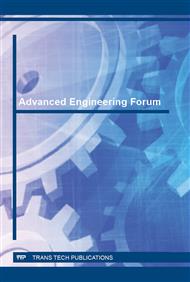[1]
M. Dijkstra, M. J. Boer, J. W. Berenschot, T. S. Lammerink, R. J. Wiegerink, M. Elwenspoek, Miniaturized flow sensor with planar integrated sensor structures on semicircular surface channels, in Proc. IEEE Micro Electro Mech. Syst. Conf. (2007).
DOI: 10.1109/memsys.2007.4433031
Google Scholar
[2]
S. Arya, S. Khan, A. Vaid, H. Kour, P. Lehana, Microfluidic Mechanics and Applications: a Review, J. Nano Electron. Phy. 5 (2013) 04047-04058.
Google Scholar
[3]
A. Qualtieri, F. Rizzi, M.T. Todaro, A. Passaseo, R. Cingolani, M. De Vittorio, Stress-driven AlN cantilever-based flow sensor for fish lateral line system, Microelectron. Engg. 88 (2011) 2376-2378.
DOI: 10.1016/j.mee.2011.02.091
Google Scholar
[4]
A. Çubukçua, G. A. Urbana, Simulation and fabrication of a 2D-flow sensor for simultaneous fluid characterization, Procedia Chemistry, 1 (2009) 887-890.
DOI: 10.1016/j.proche.2009.07.221
Google Scholar
[5]
P. Zu, C. C. Chan, W. S. Lew, L. Hu, Y. Jin, H. F. Liew, L. H. Chen, W. C. Wong, X. Dong, Temperature insensitive magnetic Field Sensor Based on Nanoparticle Magnetic Fluid and Photonic Crystal Fiber, IEEE Photonics Journal, 4 (2012) 491-498.
DOI: 10.1109/jphot.2012.2192473
Google Scholar
[6]
T. E. Tezduyar, Stabilized finite element formulations for incompressible flow computations, Advances in Applied Mechanics, 28 (1992) 1-44.
DOI: 10.1016/s0065-2156(08)70153-4
Google Scholar
[7]
Y. Saad, M. Schultz, GMRES: A generalized minimal residual algorithm for solving nonsymmetric linear systems, SIAM Journal of Scientific and Statistical Computing, 7 (1986) 856-869.
DOI: 10.1137/0907058
Google Scholar
[8]
S. Arya, S. Khan, P. Lehana, Design and fabrication of electrostatic micro-cantilever array as audible frequency generator, Journal of Electrostatics, 76 (2015) 145-151.
DOI: 10.1016/j.elstat.2015.05.015
Google Scholar
[9]
S. Arya, S. Khan, P. Lehana, Finite Element Modelling of Piezoelectric Micro-Cantilever as Gas Sensor, in Proc. of International IEEE Conference on Emerging Trends and Applications in Computer Science (ICETACS), (2013) 13-14.
DOI: 10.1109/icetacs.2013.6691418
Google Scholar
[10]
A. S. Nezhad, M. Ghanbari, C. G. Agudelo, M. Packirisamy, R. B. Bhat, A. Geitmann, PDMS Microcantilever-Based Flow Sensor Integration for Lab-on-a-Chip, IEEE Sensors Journal, 13 (2013) 601-609.
DOI: 10.1109/jsen.2012.2223667
Google Scholar
[11]
H. D. Akaydin, N. Elvin, Y. Andreopoulos, Energy Harvesting from Highly Unsteady Fluid Flows using Piezoelectric Materials, Journal of Intelligent Material Systems and Structures, 21 (2010) 1263-1278.
DOI: 10.1177/1045389x10366317
Google Scholar
[12]
A. Kuoni, R. Holzherr, M. Boillat, N. Rooij, Polyimide membrane with ZnO piezoelectric thin film pressure transducers as a differential pressure liquid flow sensor, J. Micromech. Microeng. 13 (2003) 103-107.
DOI: 10.1088/0960-1317/13/4/317
Google Scholar
[13]
A. Rasmussen, C. Mavriplis, M. E. Zaghloul, O. Mikulchenko, K. Mayaram, Simulation and optimization of a microfluidic flow sensor, Sensors Actuat. A, Phys. 88 (2001) 121-132.
DOI: 10.1016/s0924-4247(00)00503-3
Google Scholar
[14]
T. E. Tezduyar, Stabilized finite element methods for computation of flows with moving boundaries and interfaces, in Lecture Notes on Finite Element Simulation of Flow Problems (Basic - Advanced Course), Japan Society of Computational Engineering and Sciences, Japan, (2003).
DOI: 10.1007/bf02897870
Google Scholar
[15]
K. Stein, B. Griffin, Finite element modelling of fluid–structure interactions with space–time and advanced mesh update techniques, in Proc. of 10th international conference on Numerical Methods in Continuum Mechanics, (2005) 1-20.
Google Scholar
[16]
A. Masud, T. J. R. Hughes, A space–time Galerkin/least-squares finite element formulation of the Navier-Stokes equations for moving domain problems, Computer Methods in Applied Mechanics and Engineering, 146 (1997) 91-126.
DOI: 10.1016/s0045-7825(96)01222-4
Google Scholar
[17]
T. J. R. Hughes, L. P. Franca, M. Balestra, A new finite element formulation for computational fluid dynamics: V. Circumventing the Babuska-Brezzi condition: A stable Petrov-Galerkin formulation of the Stokes problem accommodating equal-order interpolations, Computer Methods in Applied Mechanics and Engineering, 59 (1986).
DOI: 10.1016/0045-7825(86)90025-3
Google Scholar
[18]
T. E. Tezduyar, S. Sathe, R. Keedy, K. Stein, Space–time finite element techniques for computation of fluid–structure interactions, Computer Methods in Applied Mechanics and Engineering, 195 (2006) 2002-(2027).
DOI: 10.1016/j.cma.2004.09.014
Google Scholar
[19]
T. E. Tezduyar, Y. Osawa, Finite element stabilization parameters computed from element matrices and vectors, Computer Methods in Applied Mechanics and Engineering, 190 (2000) 411-430.
DOI: 10.1016/s0045-7825(00)00211-5
Google Scholar
[20]
S. Arya, S. Khan, P. Lehana, Analytic Model of Microcantilevers as Low Frequency Generator, Modelling and Simulation in Engineering, Article ID 897315, (2014) 1-7.
DOI: 10.1155/2014/897315
Google Scholar
[21]
R. Ab. Rahim, B. Bais, B. Y. Majlis, Design and Analysis of MEMS Piezoresistive SiO2 Cantilever-based Sensor with Stress Concentration Region for Biosensing Applications, in IEEE proc. ICSE 2008, Malaysia, (2008) 211-215.
DOI: 10.1109/smelec.2008.4770310
Google Scholar


